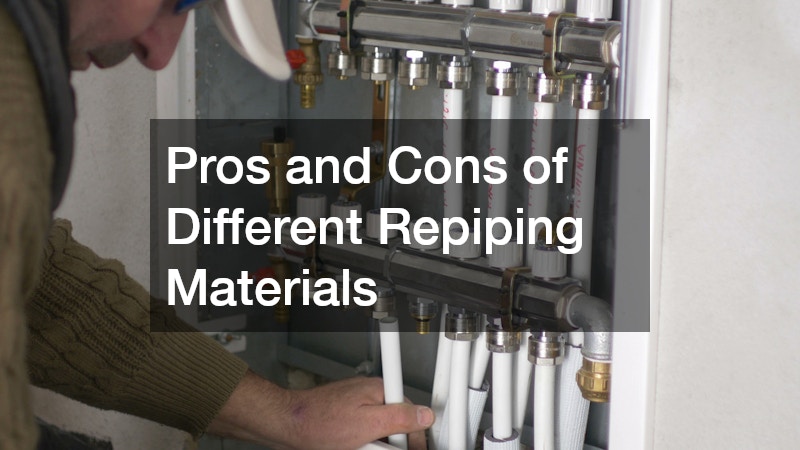Ensuring the integrity of your plumbing system is crucial. Despite its hidden nature, your home’s piping system plays a vital role in everyday conveniences like running water and effective drainage. For many homeowners, understanding the process and necessity of repiping can seem daunting, but it’s an investment in the longevity and functionality of their home.
Why Might My Home Need Repiping?
Common Signs That Indicate a Need for Repiping
Recognizing the signs that your home may need repiping can prevent more significant issues down the line. Some of the most common indicators include discolored water, low water pressure, and frequent leaks or pipe bursts.
Ignoring these warning signs can lead to increased repair costs and potential water damage.
Another immediate sign that might suggest the need for repiping is an unexplained increase in water bills. Fluctuations in your water usage might be due to hidden leaks within the walls or under the floors of your home. By addressing these symptoms early, you can save money and protect your property from further issues.
The age of your plumbing system also significantly influences its functionality. Older homes, particularly those built more than fifty years ago, often feature outdated plumbing materials that are more prone to deterioration, such as galvanized steel or polybutylene. Upgrading to new, efficient systems as part of a house repiping can greatly improve your water quality and system reliability.
Consequences of Neglecting Pipeline Replacement
Delaying the replacement of aging or failing pipelines can result in costly consequences for homeowners. One of the most immediate issues involves persistent leaks, which can cause structural damage, mold growth, and damage to personal property. Additionally, these problems can depreciate the value of your home over time.
Neglecting necessary repiping can lead to contamination issues, as older pipes may leach harmful substances into the water supply. This is particularly concerning for families with young children or elderly members, who are more susceptible to such contaminants. Ensuring the safety of your household is paramount, and effective repiping can mitigate these risks.
The Process of Repiping a House
Steps Involved in a House Repiping Project
The process of repiping a house begins with a detailed assessment by a professional plumber. This thorough inspection identifies problem areas and determines the appropriate materials and methods for your specific needs. Once the evaluation is complete, the actual work involves replacing old pipes with modern alternatives, ensuring minimal disruption to your home life.
After planning, the next step involves the strategic removal of outdated or compromised piping materials. Skilled technicians use specialized tools and techniques to carefully replace these with state-of-the-art piping options, often working in sections to maintain some water flow throughout the project. This phase requires precision and expertise to ensure the successful integration of the new system.
Timeframe and Costs Associated with Repiping
The timeframe for a repiping project can vary significantly based on the size of the home and the complexity of the existing system. Typically, most repiping jobs range from a few days to a week, but larger or older homes may require more time to complete. It is important to choose a reputable contractor who can provide an accurate timeline and adhere to scheduled goals.
Cost is another key factor, heavily influenced by the materials chosen and the scope of the project. Homeowners should be aware that while repiping represents a substantial investment, it often pays off in reduced maintenance costs and increased property value. Understanding potential costs upfront allows for better budgeting and financial planning for this essential home improvement project.
Choosing the Right Material for Repiping
Comparison of Common Materials Used in Repiping
When it comes to repiping, choosing the right material is crucial for long-term satisfaction and performance. Copper piping has been a traditional favorite due to its durability and resistance to corrosion. However, modern alternatives like PEX (cross-linked polyethylene) and CPVC (chlorinated polyvinyl chloride) have become popular for their affordability and ease of installation.
PEX is especially favored in many residential projects because of its flexibility, which allows for fewer joint issues and easier installation. On the other hand, CPVC provides excellent temperature resistance, making it suitable for hot water applications. Each material offers unique advantages and potential drawbacks depending on the specific requirements of the home.
Pros and Cons of Different Repiping Materials
Copper, while traditional and known for its longevity, tends to be more expensive and can be difficult to install due to its rigidity. Despite its higher cost, it boasts resistance to bacterial growth and high heat, making it an excellent choice for certain applications. Conversely, it is prone to corrosion if the water is highly acidic.
PEX offers a cost-effective and easy installation solution, adapting well to both hot and cold water systems. However, its susceptibility to damage from UV light exposure and potential chemical leaching remains a concern for some homeowners. Nonetheless, its flexibility often makes it a preferred choice for complex or retrofitting projects.
House repiping is a critical consideration for maintaining the safety, efficiency, and value of a home. By understanding the symptoms of failing plumbing systems, the importance of timely intervention, and the available material options, homeowners can take informed steps towards this essential upgrade. The choice of a professional and experienced contractor can make a significant difference in the smooth execution of a repiping project, ultimately safeguarding the home’s infrastructure for future generations.

